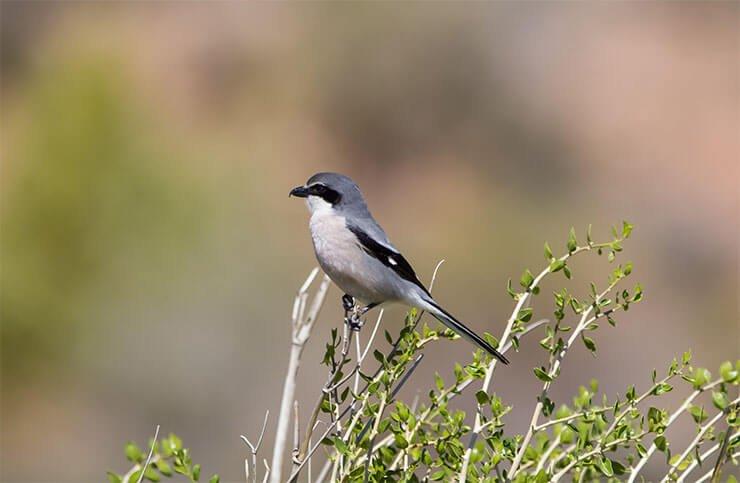The behavior of the southern gray shrike makes it one of the most striking birds; In fact, its biology leaves no one indifferent since the royal shrike (Lanius meridionalis) is one of the most unique birds that can be found in the Iberian Peninsula, in France and in the westernmost regions of Italy. Unfairly little known, the behavior of this bird is unique.
All species of shrikes have the same characteristic: although they are small birds with thin tips, they have a beak that resembles that of birds of prey, as if they used it to hunt animals.
And this characteristic has its own reason: the southern gray shrike is a small bird that hunts insects, but it is best known for its way of hunting small vertebrates. Rodents, lizards and other birds can prey on these birds, which are also known as executioners (lanius, in fact, derives from Latin and means “butcher, executioner”). But how do they do it?

The gray shrike belongs to the Laniidae family and lives in Africa, Asia and Europe, although there are some species that breed in North America, Australia and the south of the American continent.
The royal shrike has recently been separated from the excubitor (of which it was considered a subspecies), as well as for the aforementioned characteristics, especially for the ecological differences and for the well-separated and defined distribution areas. In fact, meridionalis is a typically Mediterranean species, which occupies (with several subspecies) large portions of North Africa, the Middle East, the Iberian Peninsula and, more limited, France, a country that hosts stable populations a few kilometers from the Piedmontese borders. . (Lake Serre Poncon) and Liguria (hills of Nice).
Fast facts:
The largest species of southern shrike is found in the Iberian Peninsula. It is a sedentary bird, common in dry areas and open environments such as the Canary Islands or throughout the Mediterranean slope. Recognizing this bird is very easy, so if you like bird watching it is a good bird to start with. It is a small, robust bird with a long tail. In addition to its beak, it is characterized by a black mask over its eyes. The wings of this passerine are black, with a large white spot. Much of its body, however, is gray, making it easily recognizable.

It measures just 25 centimeters, but its wingspan far exceeds 30 centimeters. Its song is metallic and powerful, as well as very varied, in fact this animal manages to imitate other birds.
The gray shrike has several subspecies and is a rare bird: in Europe, it is found only in the south of France, in Portugal, in very few areas of Italy and in Spain. It is also present in North Africa and the Canary Islands and even some areas of Asia.

The gray shrike lives in open areas; it is common to see it perched on cables and other structures. It is also possible to see it in areas of scrub, oak forests and crops such as almond or olive groves.
Regarding its habitat in Italy, it is present only in the westernmost areas. It is estimated that there are more than 500,000 specimens in southwestern Europe, although they seem to be disappearing.
The most curious thing about the southern gray shrike is its behavior: this animal, after hunting its prey, impales it on thorny plants or even on barbed wire. He then proceeds to tear it apart by pulling it with his beak, hence his nickname “butcher”.

The intelligence of the birds is well demonstrated by the southern gray shrike, which it usually hunts by stalking, while observing from above perched on electrical cables or branches. After this first phase of observation, it catches its prey and impales it on pointed branches of blackthorn, hawthorn and other plants.
Regarding its reproduction, in southern Europe it usually begins in March, while in Africa and the Canary Islands it occurs earlier. These birds build their nests in thorny trees, where they lay up to seven white eggs with black spots, from which chicks will emerge after two weeks.
Currently, the gray shrike is listed as declining throughout the European Union, with an unfavorable conservation status even at continental level. In fact, there was a large decline in the breeding population in the territories of “community” Europe in the period 1970-1990, followed by a further, but more moderate, decline in the following decade.
The breeding population in the European Union is estimated at 240,000-360,000 pairs. 90-96% of the continental population and a fraction between 5% and 24% of the world population nest in the Europe of the 27.

In general, some of the environments frequented by the species are in decline, particularly those most suitable for wintering, such as plain meadows, grassland patches, canals, rows and small wetlands. But also the moors, which seem to be increasingly contracted.
Therefore, to improve the prospects of the species it would be necessary to favor the maintenance of adequate conditions, preserving meadows and other open environments with an abundance of perches and thus favoring the presence of marginal vegetation, patches of tree-shrub vegetation. In these areas, anthropogenic disturbances must also be limited, especially in places where the regular presence of the species has been proven during the winter season.





